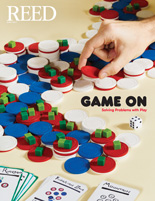
IRIS login | Reed College home Volume 96, No. 2: June 2017
Reedies Hold Union on Student Autonomy
What does “student autonomy” mean? Does the autonomy of the student body differ from that of individual students? How should student autonomy exist in practice? Does student autonomy exist at all? These were some of the questions raised Thursday night in a packed chapel in Eliot Hall for the Reed Union on Student Autonomy.
The Union, officially “Student Autonomy: Its Possibilities and its Limits," consisted of a panel of five speakers, each of whom gave short speeches before the floor was opened to the audience. Historian John Sheehy ’82, author of Comrades of the Quest, moderated the panel and opened the event. Following him was Lilli Paratore ’13, history senior and chair of the Judicial Board; professor Kris Anderson [psychology 2007–], who specializes in young adult development; professor Peter Steinberger [political science 1973–]; Dean of Students Mike Brody; and student body president Ari Galper ’14. President John Kroger was also present, but as a member of the audience rather than a panelist.
The union was a direct reaction to to this year's “spring crisis,” the Reed administration’s cancellation of three Paideia classes deemed legally threatening to the college. However, the union’s lively discussion quickly moved past the specifics of “Paideia-gate” into a broader discussion of the meaning of student autonomy at Reed. John Sheehy made the point of noting that there was never a mention of “student autonomy” in any student constitution. President William Foster’s original vision was of a constant and creative tension between responsibility and freedom in the student body. In a similar fashion Peter Steinberger suggested that asking about “student autonomy” was the wrong question entirely: instead, he argued, we should think about “obligation,” as it shared between all constituents of the Reed community. He suggested that Reed must not forget that it is a school, not a business, and its relationships are not those of the free market.
Mike Brody made it clear that, unfortunately or not, Reed does exist in the broader world and is subjected to the pressures of that world. As the night wore on this question of external pressures became central: how can student autonomy exist when Reed’s administration must respond to demands outside of its control? The audience probed this issue with questions such as, “Is it possible for the institution to contract after an expansion?” and “What parts of student autonomy are sacred?”
The union ended with five students still waiting to ask their questions, and the debate spilled onto the Great Lawn as the audience exited the chapel. No consensus was reached, but the conversation on student autonomy will doubtless continue—and so will William Foster’s vision of creative tension.
Tags: student autonomy, reed union, chapel


LATEST COMMENTS
steve-jobs-1976 I knew Steve Jobs when he was on the second floor of Quincy. (Fall...
Utnapishtim - 2 weeks ago
Prof. Mason Drukman [political science 1964–70] This is gold, pure gold. God bless, Prof. Drukman.
puredog - 1 month ago
virginia-davis-1965 Such a good friend & compatriot in the day of Satyricon...
czarchasm - 4 months ago
John Peara Baba 1990 John died of a broken heart from losing his mom and then his...
kodachrome - 7 months ago
Carol Sawyer 1962 Who wrote this obit? I'm writing something about Carol Sawyer...
MsLaurie Pepper - 8 months ago
William W. Wissman MAT 1969 ...and THREE sisters. Sabra, the oldest, Mary, the middle, and...
riclf - 10 months ago